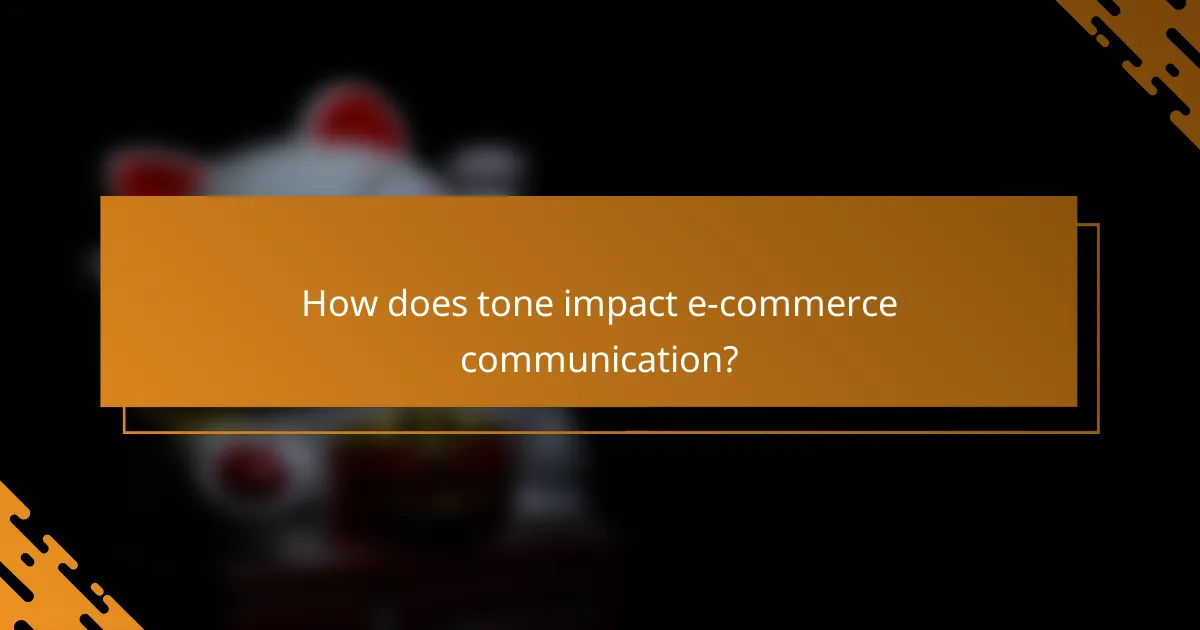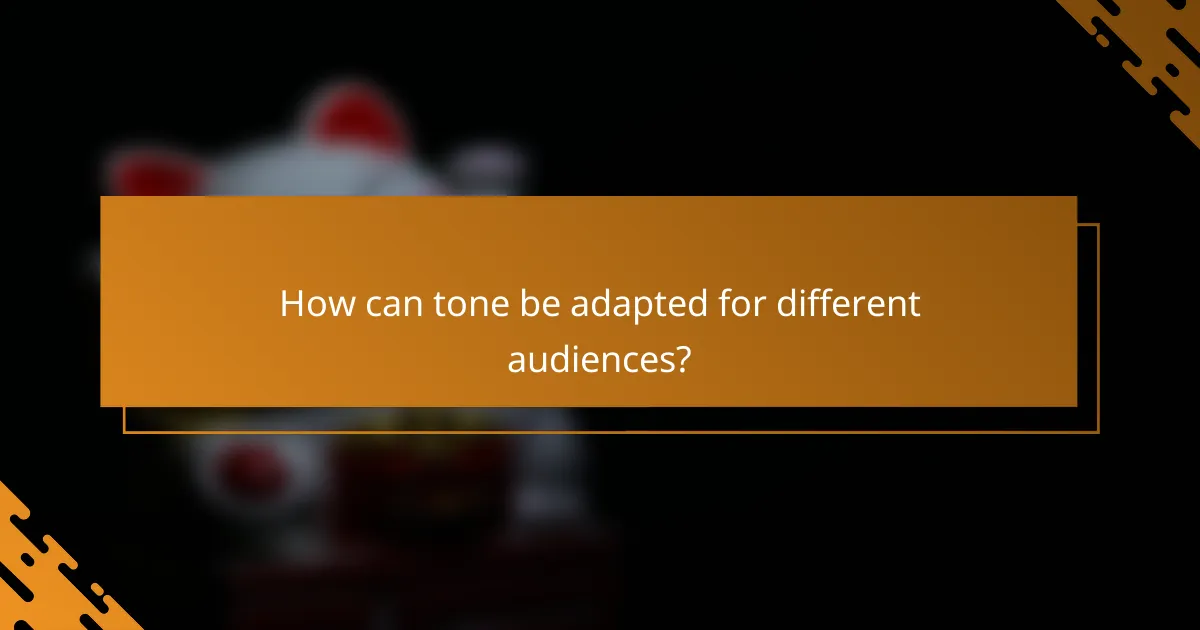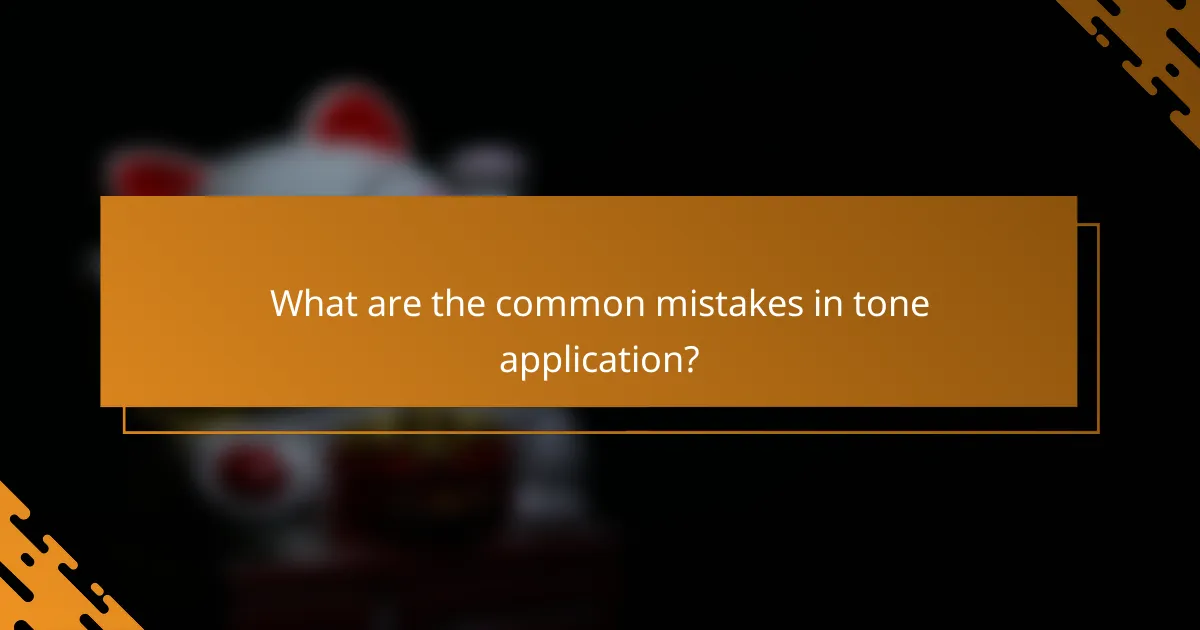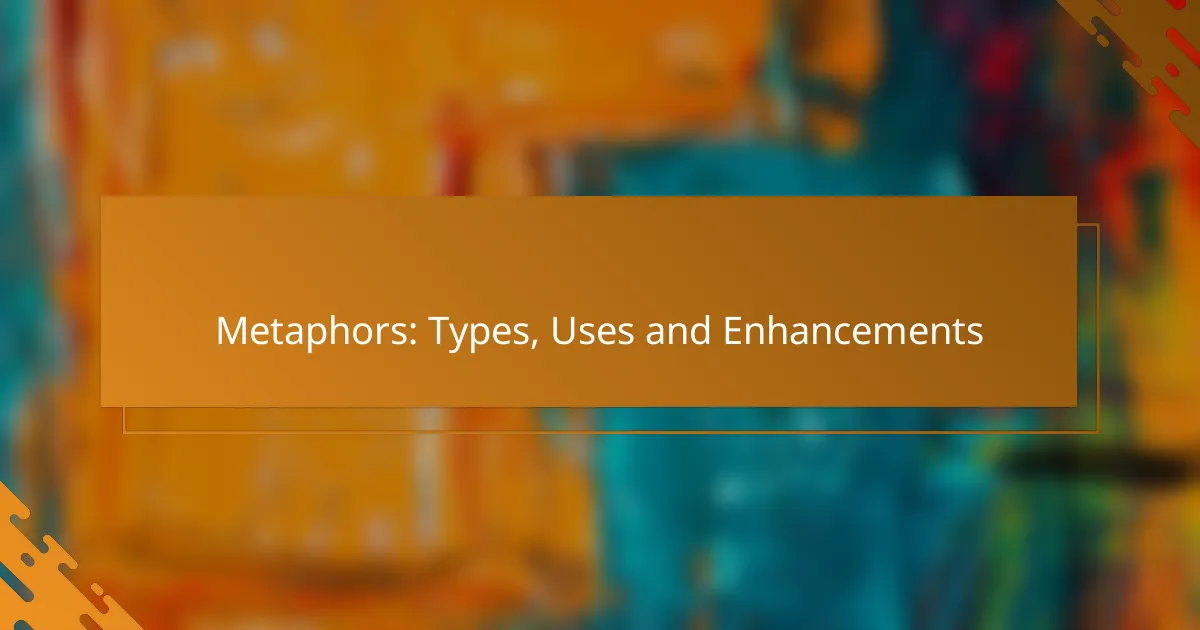The tone of communication in e-commerce plays a crucial role in shaping customer perceptions and influencing their purchasing decisions. By adopting a consistent and engaging tone, brands can enhance customer experiences, build trust, and encourage loyalty. Effective strategies for improving tone include understanding the audience, employing a conversational style, and crafting compelling narratives that resonate with customers.

How does tone impact e-commerce communication?
The tone of communication in e-commerce significantly affects how customers perceive brands, influencing their purchasing decisions and overall satisfaction. A consistent and appropriate tone can enhance the customer experience, fostering trust and encouraging repeat business.
Influences customer perception
The tone used in e-commerce communication shapes customer perception by conveying brand personality and values. For example, a friendly and approachable tone can make a brand seem more relatable, while a formal tone may suggest professionalism and reliability.
Consider using a conversational tone in customer service interactions to create a welcoming atmosphere. Avoid overly technical jargon unless your audience expects it, as this can alienate potential buyers.
Affects brand loyalty
Consistent tone in messaging can significantly impact brand loyalty. When customers feel a connection through the tone, they are more likely to return for future purchases. A warm, engaging tone can create a sense of community, encouraging customers to choose your brand over competitors.
To build loyalty, ensure that your tone aligns with your brand values across all platforms, from social media to email marketing. This consistency reinforces customer trust and encourages long-term relationships.
Enhances customer engagement
An engaging tone can enhance customer interaction and participation. Brands that use a lively, enthusiastic tone in their communications often see higher engagement rates, as customers feel more compelled to interact with the content.
Utilize storytelling techniques and relatable language in your marketing materials to draw customers in. Incorporating questions or calls to action in a friendly tone can also prompt customers to respond, increasing overall engagement.

What techniques improve tone in marketing?
Improving tone in marketing involves strategies that resonate with your audience and create a connection. Key techniques include understanding your customers, using a friendly conversational style, and weaving narratives that engage and inspire.
Utilizing customer personas
Customer personas are fictional representations of your ideal customers based on research and data. By developing detailed personas, you can tailor your tone to match the preferences and behaviors of different segments of your audience. This ensures that your messaging feels relevant and personal.
To create effective customer personas, gather information through surveys, interviews, and analytics. Consider factors such as demographics, interests, and pain points. Aim for a diverse range of personas to cover various customer types, which can help refine your marketing tone across different campaigns.
Adopting a conversational style
A conversational style makes your marketing feel more approachable and relatable. This technique involves using simple language, asking questions, and addressing the audience directly. It helps break down barriers and fosters a sense of connection with potential customers.
To adopt a conversational tone, avoid jargon and overly formal language. Use contractions and personal pronouns to create a friendly atmosphere. For instance, instead of saying “we will provide you with,” say “we’ll give you.” This small shift can significantly enhance how your message is received.
Incorporating storytelling
Storytelling is a powerful tool in marketing that can evoke emotions and create memorable experiences. By sharing stories that reflect your brand values or customer experiences, you can engage your audience on a deeper level and make your message more impactful.
When incorporating storytelling, focus on relatable characters, challenges, and resolutions. Use real-life examples or case studies to illustrate how your product or service has made a difference. This approach not only enhances your tone but also builds trust and credibility with your audience.

What are the best practices for tone consistency?
Best practices for tone consistency involve establishing clear guidelines, training staff, and conducting regular audits. These practices ensure that all communications reflect the brand’s voice and resonate with the target audience.
Establishing brand voice guidelines
Brand voice guidelines serve as a foundational document that outlines the desired tone and style for all communications. This includes defining key attributes such as whether the tone should be formal, friendly, authoritative, or casual. Providing examples of preferred language and phrases can help staff understand how to apply these guidelines in practice.
Consider creating a simple chart that categorizes tone attributes and corresponding examples. For instance, a friendly tone might use phrases like “We’re here to help!” while a formal tone might prefer “We are available to assist you.” This clarity helps maintain consistency across various platforms.
Training staff on tone usage
Training staff on tone usage is crucial for ensuring everyone understands and can effectively implement the brand’s voice. Regular workshops or training sessions can provide practical exercises that allow employees to practice writing in the established tone. Role-playing scenarios can also help staff navigate different communication contexts.
Encourage feedback during training sessions to identify areas where staff may struggle with tone consistency. Providing resources, such as a tone reference guide, can further support employees in their daily communications.
Regular tone audits
Conducting regular tone audits helps assess whether communications align with the established brand voice guidelines. This process involves reviewing various content types, such as emails, social media posts, and marketing materials, to identify inconsistencies or deviations from the desired tone.
Set a schedule for audits, such as quarterly or biannually, and involve a diverse team to provide different perspectives. Use a checklist to evaluate tone consistency, ensuring that all communications reflect the brand’s voice and resonate with the intended audience.

How can tone be adapted for different audiences?
Adapting tone for different audiences involves understanding their preferences, values, and communication styles. By tailoring your message to fit these factors, you can enhance engagement and ensure your content resonates effectively.
Segmenting audience demographics
Segmenting audience demographics is crucial for adapting tone. Consider factors such as age, gender, education level, and socioeconomic status. For instance, a younger audience may respond better to informal language and humor, while a more mature audience might appreciate a formal and respectful tone.
Utilize surveys or analytics tools to gather demographic data, which can guide your tone adjustments. Creating audience personas can also help in visualizing and understanding the specific needs and preferences of different groups.
Tailoring messages for cultural contexts
Cultural context significantly influences how tone is perceived. Different cultures have varying norms regarding communication styles, humor, and directness. For example, a direct approach may be appreciated in some Western cultures, while indirect communication might be preferred in many Asian cultures.
Research cultural sensitivities and local customs before crafting your message. This ensures that your tone aligns with the audience’s expectations and avoids potential misunderstandings or offense.
Adjusting tone for different platforms
Each platform has its own conventions and audience expectations that necessitate tone adjustments. For example, social media platforms like Twitter require a concise and often casual tone, while professional platforms like LinkedIn call for a more formal and polished approach.
Consider the nature of the content and the platform’s audience when adjusting your tone. A blog post may allow for a conversational style, whereas a corporate report should maintain a serious and authoritative tone. Always align your tone with the platform to maximize effectiveness.

What are the common mistakes in tone application?
Common mistakes in tone application include inconsistency across communication channels, using overly formal language, and neglecting audience feedback. These errors can lead to confusion, disengagement, and a disconnect between the brand and its audience.
Inconsistency across channels
Inconsistency in tone across different channels can confuse your audience and dilute your brand identity. For example, a casual tone on social media may clash with a formal tone in email newsletters, leading to mixed messages. To maintain coherence, establish clear tone guidelines that apply to all platforms.
Regularly review your content across channels to ensure alignment. A simple checklist can help: verify that the language, style, and messaging are consistent, regardless of whether it’s a blog post, social media update, or customer service interaction.
Overly formal language
Using overly formal language can alienate your audience and make your content feel inaccessible. For instance, technical jargon or complex vocabulary may be appropriate in certain contexts, but it can hinder engagement in more casual settings. Aim for a conversational tone that resonates with your target demographic.
To avoid this pitfall, consider your audience’s preferences and adjust your language accordingly. A good rule of thumb is to use simple, clear language that encourages interaction and connection, especially in customer-facing communications.
Neglecting audience feedback
Neglecting audience feedback can result in a tone that does not resonate with your target market. Regularly soliciting and analyzing feedback helps you understand how your tone is perceived and whether it aligns with audience expectations. Ignoring this input can lead to missed opportunities for improvement.
Implement feedback mechanisms such as surveys or social media polls to gather insights. Use this data to refine your tone and ensure it meets the needs and preferences of your audience, fostering a stronger connection and enhancing engagement.

How can emerging trends influence tone in e-commerce?
Emerging trends significantly shape the tone in e-commerce by dictating how brands communicate with their audiences. As consumer preferences evolve, businesses must adapt their messaging to resonate with current sentiments and expectations.
Shifts in Consumer Behavior
Changes in consumer behavior, such as increased demand for authenticity and transparency, directly impact the tone e-commerce brands adopt. For instance, brands that emphasize genuine storytelling and ethical practices often cultivate a more relatable and trustworthy tone.
To align with these shifts, e-commerce businesses should focus on using conversational language and engaging narratives that reflect their values. This approach can enhance customer loyalty and foster a deeper connection with the audience.
Technological Advancements
Technological advancements, including AI-driven personalization and interactive content, influence the tone by enabling more tailored communication. Brands can now analyze customer data to create personalized experiences that resonate with individual preferences.
For example, using chatbots with a friendly and approachable tone can enhance customer interactions, making them feel valued and understood. E-commerce platforms should leverage technology to maintain a consistent yet adaptable tone across various channels.
Social Media Trends
Social media trends play a crucial role in shaping the tone of e-commerce communications. Platforms like Instagram and TikTok encourage brands to adopt a more casual and engaging tone to connect with younger audiences.
Brands should consider incorporating humor, memes, or trending challenges into their messaging to stay relevant. However, it’s essential to ensure that the tone aligns with the brand’s identity and values to avoid appearing inauthentic.
Global Market Influences
As e-commerce expands globally, cultural nuances and regional preferences influence tone. Brands must adapt their messaging to resonate with diverse audiences while respecting local customs and languages.
For instance, a brand may adopt a more formal tone in markets where professionalism is valued, while using a casual tone in regions that favor a relaxed approach. Understanding these cultural contexts is vital for effective communication and brand acceptance.


